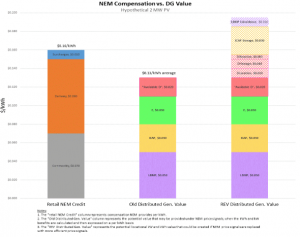Comparing NYS with CA: Blog 5 – A CA and NYS similarity: mapping DER via a regulated process
This is the fifth in a series of blogs comparing the New York State and Californian energy and regulatory policies
Catherine Mitchell, IGov Team, 20th June 2017
This is the fifth blog in a blog series comparing CA and NYS energy and regulatory policies. The first blog provides an overview of the series, with links. The second blog provides an update of the NYS regulatory process, the NY REV. The third blog provides an overview of the Californian energy and regulatory process. The fourth blog provides a high level comparison of the principles and key actions of CA and NYS energy policy. The sixth blog discusses the differences between DNOs, DSOs and DSPs.
Flexibility is the key to a rapid, cost effective transformation to a sustainable, secure and affordable energy system.
An essential step in transforming to a sustainable, secure and affordable energy system is to encourage a flexible, integrated and coordinated (across electricity, heat and electric vehicles) energy system operation. This requires building (and valuing) distributed energy resources (DER, for both supply and demand). And to do this cost effectively, it is essential to know what the DER resource base is of an area. Only when this is known is it possible to value that DER; and only when DER value is known, is it possible to understand the emerging economics of D4 (the move towards decentralisation, decarbonisation, digitalisation and democratisation). The amount of DER in an area, and the degree to which it is incorporated into system operation has major implications for how networks are charged for; how they are regulated; the type of tariffs which should complement a DER system, and so on.
Given the centrality of flexibility and DER to energy system transformation, both CA and NYS have instituted a regulated process to reveal their DER resource and value. In both cases, they have required distribution utilities to undertake distribution resource plans, and have given them a couple of years to complete them. In CA, this is called a distribution resource plan (DRP) and in NYS it is called a distribution system implementation plan (DSIP). The process of developing them opens up access to data; it involves all interested stakeholders; it provides a space where stakeholders, which might not otherwise have thought much about DER, are forced to connect to some degree to DER possibilities.
It seems to IGov that the GB Regulator should require the GB utilities to undertake a similar, regulated process for their areas for two important reasons:
- Flexibility is central to a sustainable, secure and affordable energy system. Accessing flexibility value is the bottleneck to that system. The essential first step is finding out what that DER resource is in a coherent and joined up way across GB – DNO by DNO area. As a recent blog about RIIO argued, the LCNF projects and pilots have not led to any substantial movements forward in terms of active DNO operation – despite their expense. GB should move beyond these pilots and regulate to produce DNO distribution resource plans – just like CA or NYS.
- Secondly, the basis of a successful distribution market facilitating function (i.e. a distribution service provider, distributed system provider etc.) is knowledge about the DER in the local area, and its value at different times of the day.
The DRP / DSIPs are therefore essential building block for both the successfully functioning of the new, potentially transformational, institutions – distribution service providers – , and to enable a flexible energy system.
Californian distributed energy resource policy (DER)
As set out in the third blog and below, CA energy policy (arguably) has five key pillars. This blog focuses on their ‘decarbonisation by building distributed energy resources’ pillar.
Decarbonisation by Developing DER
The CPUC Scoping Note of 2014 set up Distribution Resource Plan (DRP) proceedings (the equivalent of the 2015 NYS Distribution System Implementation Plans) whereby CA Investor Owned Utilities (IOU) are required to produce a DRP (see here). The Scoping Note argued that the underlying rationale for promoting increased deployment of DERs is that they have a critical role in meeting CA’s GHG reduction policy. The goals of the DRP Plans were to:
- modernise the electric distribution system to accommodate two-way flows of energy and energy services throughout the IOU networks;
- enable customer choice of new technologies and services that reduce emissions and improve reliability in a cost efficient manner
- to animate opportunities for DER to realise benefits through the provision of grid services, and to enable a plug and play distribution grid for DER (p.3-5)
The intent of the Scoping Note was very little different in terms of outcomes from that set out in the 2014 Vision Paper of the New York Reforming the Energy Vision (see here and here), and discussed below. Moreover, the DRPs were also to be aligned with More Than Smart, a progressive initiative which paints a much more integrated and market based future, and puts forward ideas about how to get there.
The DRPs have been followed up with the November 2016 CPUC DER Action Plan, which has five Actions to be undertaken in 2017; three in 2018 and one in 2019. At root, the DER Action Plan process should work out:
- how to accommodate more DERs cost effectively, and work out the value of DERs when they are procured either individually (i.e. DG PV alone) or as a portfolio (DG PV plus storage etc.);
- make the wholesale and retail markets more responsive to DERs;
- link DER more with CAISO, including with storage (see here and here). CAISO has long had contracts for demand response and so forth but it now beginning to develop contracts with DER providers, or DERPs, which have to register to (potentially) access a new revenue stream (see here).
- Encourage a more integrated CA energy system.
Two 2017 Action Plan actions (see here) was to set up two demonstration projects to help work out the value of DER (see here): This is the Integration Capacity Analysis (ICA) proceedings (known as Demonstration Project A) and the Locational Net Benefit Analysis (LNBA) known as Demonstration Project B). These are both to be finished by 2018, and should provide a better understanding of the value of DER to the CA system. Two of the 2018 Actions are to then execute the Project A and B results.
The New York Reforming the Energy Vision (NY REV) Distribution System Implementation Plan (DSIP)
One pivotal area of the 2014 NY REV/ 2015 Vision Order (see blog 2), expanded on by the 2015 MDPT, was that of the role of distributed system providers (DSPs). The current distribution utilities within NYS are expected to transform to DSPs – essentially distribution energy and system service market facilitators and coordinators – who would also be responsible for the public service obligation (PSO). The MDPT report set out the argument behind why utilities need to understand their area distribution energy resources (DER) in detail; a requirement for them to produce a distribution system implementation plan (DSIP); and an explanation of what a DSIP should consist of, how to write one, and how long it would take (about 2 years). The writing of the DSIPs is the process which essentially forces the utility, and other stakeholders (i.e. providers of resource, customers, new entrants, the utility itself), to understand at the most detailed level what the implications are for all stakeholders of being in a regulatory environment which is transforming the distribution utility environment into a DSP environment. Having understood the DER resource in an area, the DSIP was to provide confidence to the wider community that DSPs would, over (broadly) a 10 year period, develop into:
- DSP platform / markets to support 3rdparty investment in DERs;
- benefit utility customers by reducing overall electric system costs and provide them with new services;
- ‘animate’ the distribution level markets through various mechanisms; and
- provide efficient, linked role between the DSPs and NYISO.
The 2015 Market Design and Platform Technology Report also kicked off various Working Groups to work out various technical and economic issues of the NY REV. Please see the NY REV website for details. These Working Groups are now beginning to be published (e.g. see here).
Valuing DER in NYS
NYS has moved one step further than California in valuing DER. This is mainly because NYS is envisaging the development of DER market activity. One important aspect of that is not just working out what DER they have, but also valuing it. In mid-November 2016, the staff proposal for methodology for valuation of DER in NYS (VDER) was published. The VDER 4 basic components, as shown in Figure 1 below, and known as the value stack, are:
- the base locational marginal price of energy (LMP)
- the capacity value
- the credit for the environmental benefits of carbon-free energy
- a market transition credit
In March 2017, the PSC value of DER Order was published with three dockets from the PSC: (1) an introduction to the Value of Distributed Energy Resources (here), (2) Distributed System Implementation Plans (here), and (3) the Interconnection Earnings Adjustment Mechanisms (here). All of these Orders are more detailed workings of previous more generally stated agreements, and will be central to how different entities, including distribution utilities, can make money. This second docket, with respect to DSIPs, was to place more pressure on the utilities to fulfil them.

Figure 1 The Value Stack of Distributed Energy Resources in NYS (NYSDPS)
DRPs and DSIPs as a fundamental first step towards a flexible energy system, and a transformation distribution system / service provider
There are many competing names for distribution market facilitator (and a review and explanation of their functions is provided in the sixth blog in this series). Whatever their name, the basis of a successful distribution market facilitating function is knowledge about the DER in the local area, and its value at different times of the day. The DRP / DSIPs are the essential building block for both (1) the successfully functioning of these new, potentially transformational, institutions (ie the DSPs), and (2) to enable a flexible energy system.
Conclusion
Undertaking a regulated, transparent, distributed energy resource plan (DRP) or DSIP to a known timeline is a fundamental requirement of the move to a cost-effective, flexible energy system. IGov considers these plans to be potentially transformational, and would argue that all electricity systems would benefit from in-depth studies of their DER potential and value. Certainly, IGov argues that Ofgem should require similar plans to be undertaken via the regulated process in GB.
Related Posts
« Previous Comparing NYS with CA: Blog 4 – a comparison of the fundamental regulatory principles Global Insight 9 – 20th June Next »








